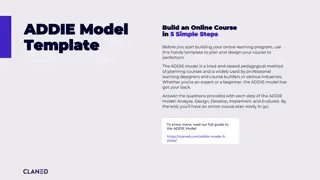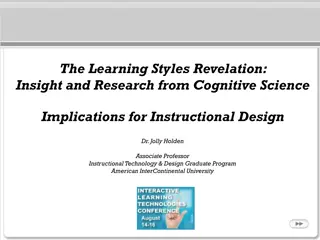Understanding the ADDIE Model in Instructional System Development
The ADDIE Model, a common model in curriculum design, consists of five key elements: Analysis, Design, Development, Implementation, and Evaluation. Each stage plays a crucial role in creating effective instructional systems, catering to educational and training environments. Subject Matter Experts, data gathering, blueprinting objectives, pilot testing, and content evaluation are essential components of the ADDIE framework, ensuring efficient curriculum development and implementation.
Download Presentation

Please find below an Image/Link to download the presentation.
The content on the website is provided AS IS for your information and personal use only. It may not be sold, licensed, or shared on other websites without obtaining consent from the author. Download presentation by click this link. If you encounter any issues during the download, it is possible that the publisher has removed the file from their server.
E N D
Presentation Transcript
Terms Defined Instructional System Development General label for a variety of curriculum development elements Applies to educational and training environments
Terms Defined Instructional System Organized collection of instructional resources Project Single design effort using instruction sytem
Terms Defined Subject Matter Expert (SME) Persons that are experts in subject matter being designed
ADDIE Model Very Common model among curriculum designers Contains five (5) elements Analysis Design Development Implementation Evaluation
ADDIE Model Analysis = input element Design Development Implementation Evaluation = = = = process element process element output element process element Elements will overlap some because the system is dynamic
Analysis Data gathering element Frame the problem/challenge Budget Resources Data and analysis
Design Blueprinting stage Objectives Course Content Design Plan
Development Materials production Lesson Plan Pilot testing non-designers see progress
Pilot Testing Test run of content Allows organizations to implement changes before the expense of material development is realized. Brings designers and SMEs together to ensure the design plan works.
Implementation Content is delivered Evaluation is used in this stage to gauge the degree in which learners meet objectives
Evaluation Takes place in all elements Constant Sentinel
Advantage/Disadvantage of ISD Advantage Ability to design quickly and efficiently All elements of curriculum design are included Disadvantage Have to be familiar with the ISD process
Operational ADDIE Viewing key operational steps in each phase as would be viewed from a designer perspective
Operational ADDIE Analysis Frame the challenge/problem/issue Is it instructional or non-instructional? Perform necessary analysis and gather data Determine resources Budget Timeline Project sign-off Evaluate
Operational ADDIE Design Blueprint Draft a design plan Rationale Objectives Population/audience Course Description Learner and facilitator pre-requisites Evaluation Strategy Deliverables Evaluate
Operational ADDIE Development Lesson Plan Draft Materials Draft online content (if applicable) Pilot test Modify content based on pilot testing Evaluate
Operational ADDIE Implementation Project active Evaluate (Kirkpatrick levels 1-3) Reaction Learning Behavior Modify as necessary Evaluate
Operational ADDIE Evaluation Review all ADDIE elements Revise evaluation process
Needs Assessment Resources Needed Instructional Systems: ADDIE Model Analysis Draft budget and timeline Rationale Course Description Evaluation Strategy Design Plan Objectives Learner/Facilitator prerequisites Deliverables Design Population Profile Lesson Plan Attention Direction Recall Content Feedback Closure Lesson Plan Job Aids Evaluation checklists Pilot test (as applicable) Development Job Aids Make active Evaluate Implementation Modify as needed Review all ADDIE elements Evaluation Resource: ISD From the Ground Up. Chuck Hodell























